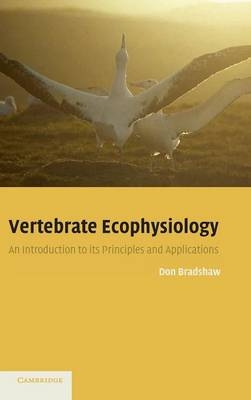
Vertebrate Ecophysiology
An Introduction to its Principles and Applications
Seiten
2003
Cambridge University Press (Verlag)
978-0-521-81797-4 (ISBN)
Cambridge University Press (Verlag)
978-0-521-81797-4 (ISBN)
Ecophysiology attempts to clarify the role and importance of physiological processes in the ecological relations of species in their natural habitats. Using examples from a wide range of vertebrates, this textbook will provide a fascinating introduction to the study of ecophysiology for advanced undergraduates and postgraduate students.
Ecophysiology attempts to clarify the role and importance of physiological processes, such as digestion and respiration, in the ecological relations of species in their natural habitats. The basic principles and methods that are central to any ecophysiological study are outlined and discussed, including animal capture, blood collection, and the measurement of plasma components and hormone levels. Attention is paid to animal welfare and ethical considerations, and the question of stress and how to identify its presence in animals in their natural environment is approached through a series of case studies. Examples are given from a wide range of vertebrates living in deserts, cold climates and oceans, and recent findings on the physiological adaptations of Antarctic birds and mammals are a highlight of the book. This textbook will provide an introduction to the study of ecophysiology for advanced undergraduates and postgraduate students, as well as researchers in ecology, biodiversity and conservation.
Ecophysiology attempts to clarify the role and importance of physiological processes, such as digestion and respiration, in the ecological relations of species in their natural habitats. The basic principles and methods that are central to any ecophysiological study are outlined and discussed, including animal capture, blood collection, and the measurement of plasma components and hormone levels. Attention is paid to animal welfare and ethical considerations, and the question of stress and how to identify its presence in animals in their natural environment is approached through a series of case studies. Examples are given from a wide range of vertebrates living in deserts, cold climates and oceans, and recent findings on the physiological adaptations of Antarctic birds and mammals are a highlight of the book. This textbook will provide an introduction to the study of ecophysiology for advanced undergraduates and postgraduate students, as well as researchers in ecology, biodiversity and conservation.
Don Bradshaw is Professor of Zoology at The University of Western Australia, Perth.
Introduction; 1. Homeostasis: a fundamental organising paradigm in ecophysiology; 2. Stress - the concept and the reality; 3. Basic methods used in ecophysiological studies; 4. Turnover methodology - theory and practice; 5. Case studies of stress - incidence and intensity; 6. Survival in deserts; 7. Torpor and hibernation in cold climates; 8. Marine birds and mammals; 9. Conclusion.
| Erscheint lt. Verlag | 24.4.2003 |
|---|---|
| Zusatzinfo | 29 Tables, unspecified; 18 Halftones, unspecified; 67 Line drawings, unspecified |
| Verlagsort | Cambridge |
| Sprache | englisch |
| Maße | 152 x 229 mm |
| Gewicht | 610 g |
| Themenwelt | Studium ► 1. Studienabschnitt (Vorklinik) ► Physiologie |
| Naturwissenschaften ► Biologie ► Ökologie / Naturschutz | |
| Naturwissenschaften ► Biologie ► Zoologie | |
| ISBN-10 | 0-521-81797-8 / 0521817978 |
| ISBN-13 | 978-0-521-81797-4 / 9780521817974 |
| Zustand | Neuware |
| Haben Sie eine Frage zum Produkt? |
Mehr entdecken
aus dem Bereich
aus dem Bereich


